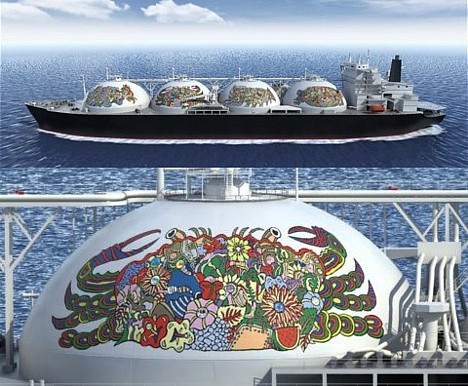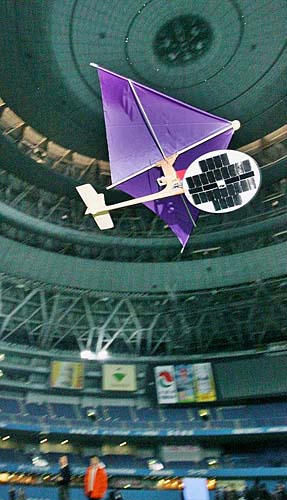
The Dream Tanker, one of the largest liquified natural gas (LNG) tankers in the world, now travels in style. Comedian-turned-painter Jimmy Onishi and 40 elementary school students have designed monster-sized psychedelic murals for the ship's spherical tanks. The total area covered by the murals is large enough to cover 100 buses.
The 120,000-ton Dream Tanker, owned by an affiliate of Osaka Gas, measures 289.5 meters (950 feet) long and 49 meters (160 feet) wide. With 4 independent spherical tanks measuring 43 meters (140 feet) in diameter, the tanker can hold up to 67,000 tons of LNG.
Osaka Gas decided to decorate the tanker with graphics in celebration of the company's 100th anniversary. The company asked Kansai-area elementary school students to draw pictures, which Jimmy Onishi then incorporated into his giant images of a fish, crab, shrimp and turtle. Sumitomo 3M Ltd. then used computers to process the images and printed them onto a special adhesive film, which was attached to the tanks.
The total surface area of the images amounts to about 4,000 square meters (43,000 square feet, or 1 acre), prompting Sumitomo 3M to submit an application to the Guinness Book of World Records to officially establish the work as the world's largest graphic design on a mode of transportation.
For more images, visit the official Dream Tanker website (Flash alert!). After you get past the Flash introduction, click on the second button on the right. That will take you to a control interface where you can zoom in on the ship and view it from different angles.
[Source: Garbagenews]

 Robo-Fisher, a submersible robot designed to clean the floors of giant aquariums, is being developed by Osaka City University and eight private companies. Underwater operations were tested last week at a diver training pool in Osaka.
Robo-Fisher, a submersible robot designed to clean the floors of giant aquariums, is being developed by Osaka City University and eight private companies. Underwater operations were tested last week at a diver training pool in Osaka. An unmanned aircraft powered by a ground-based laser was demonstrated at Osaka Dome on March 7. The aircraft is the work of a Kinki University research team led by Professor Nobuki Kawashima (aeronautical engineering). The researchers expect the aircraft to be used for gathering information in the event of a disaster.
An unmanned aircraft powered by a ground-based laser was demonstrated at Osaka Dome on March 7. The aircraft is the work of a Kinki University research team led by Professor Nobuki Kawashima (aeronautical engineering). The researchers expect the aircraft to be used for gathering information in the event of a disaster.